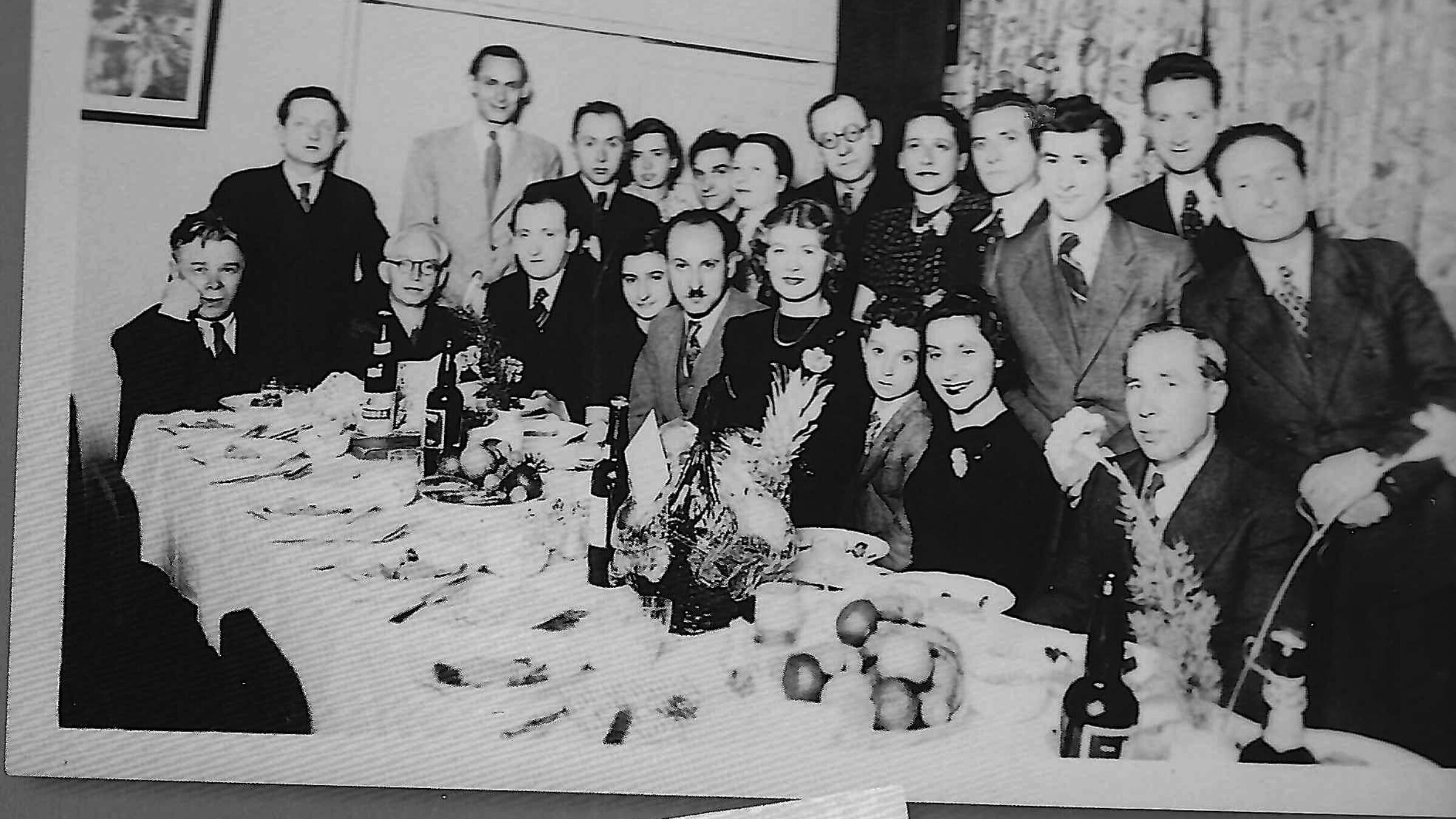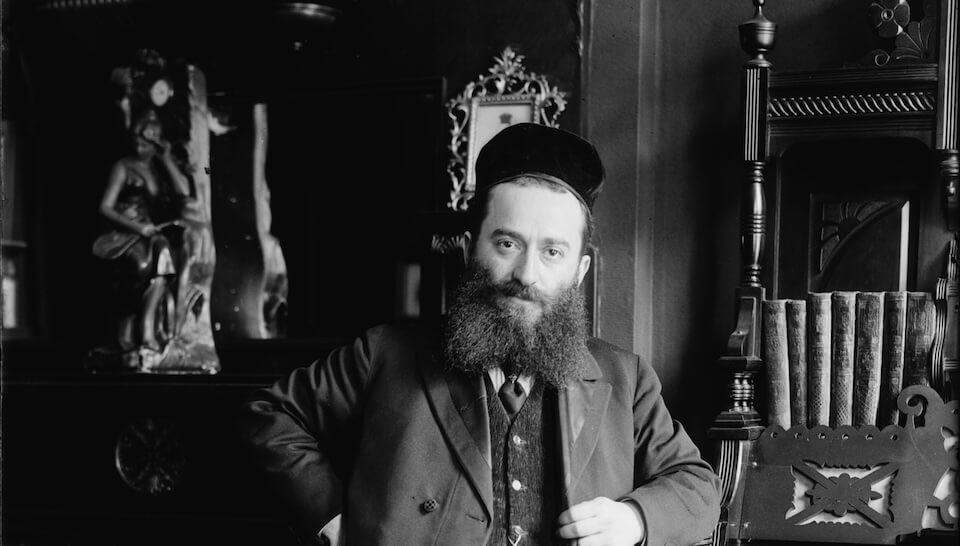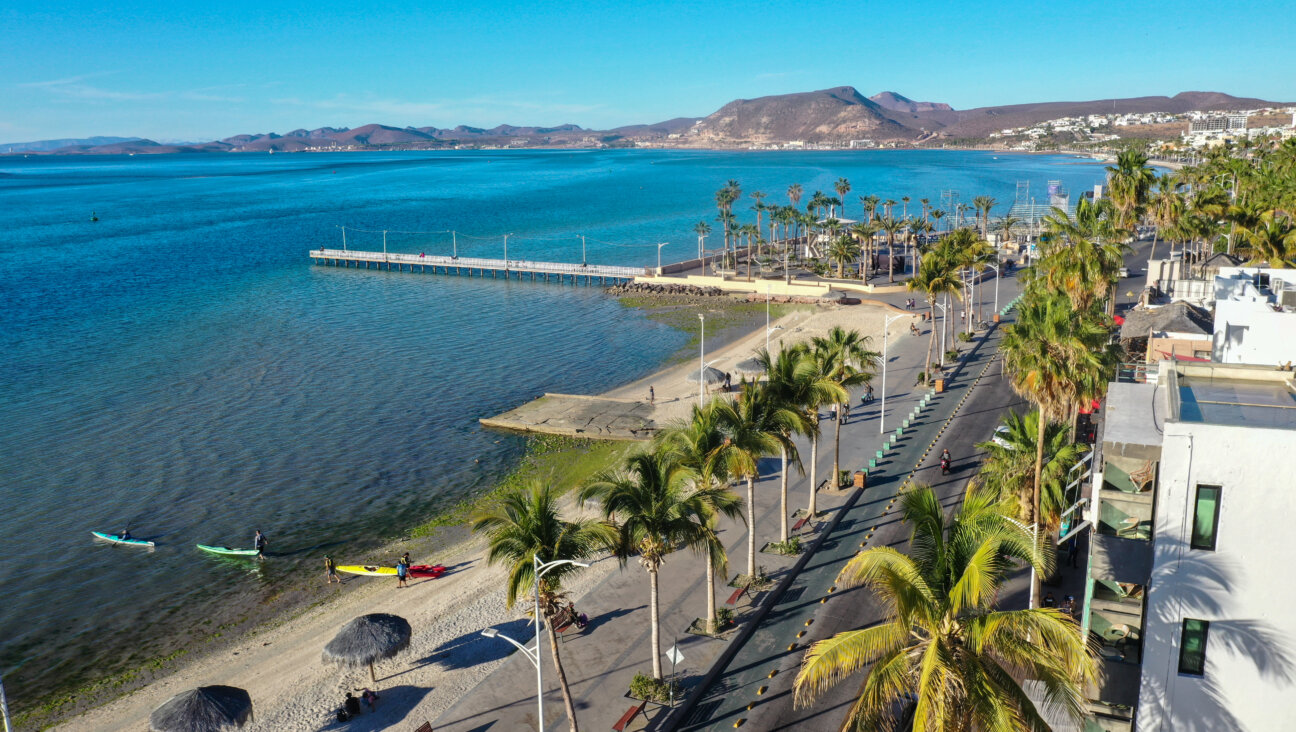How Jewish refugees managed, against all odds, to make a Seder in 1941 in Kobe, Japan
In her diary, the actress Shoshana Kahan described how difficult it was to find eggs to make the matzah balls

Shoshana Kahan is the woman wearing pearls in the center Courtesy of Digital Theatrical Archive
In 1939, the Yiddish actress and writer R. Shoshana Kahan (1895-1968), aka Rose Shoshana, was on a theatrical tour of Poland when it was suddenly cut short due to the outbreak of World War II. She and her husband, Lazar Kahan, a Bundist activist and journalist, fled to Vilna and then to Kovno, Lithuania, where they received transit visas through Japan. In 1941, they made their way by ship from Vladivostok to Kobe, Japan, finding refuge from March until late October, 1941.
After the war ended, Kahan immigrated to the United States. She was among the first to write about the Holocaust in the Yiddish press. In her memoir, In fayer un in flamen [In Fire and in Flames], published in 1949 in Buenos Aires, she describes her experience of Warsaw under siege, her flight through Eastern Europe, and, later, her life in Japan and the Shanghai Ghetto. In this excerpt, recently translated by Sheva Zucker, Kahan presents a rare picture of a Seder among refugees in Kobe, Japan where such customs were certainly seen as exotic.
During the time that Kahan was in Kobe, she kept a diary and it was there that she wrote the following entries.
April 9, 1941:
It’s a few days before Peysekh (Passover). My heart aches. Once again, Passover in a strange land. And you can’t see an end to the wandering. Everybody is sad today. The longed-for visas have not come. True, the country is incredibly beautiful, but you can’t live with just the beauty of nature. And so we pass the days sending telegrams. If the visas don’t arrive, how will we be able to stay there?
Sunday, April 13:
The first days of Passover are over and we managed to celebrate both seders. Friday, the day before Passover, I came to the committee, as always, to meet acquaintances and read the list of people who had received mail. Maybe there’s a letter for me. Yellow tired faces, bearing witness to the difficult days that they’ve lived through, are hanging around. Their eyes filled with fear, like sheep before being slaughtered. Like shadows near the committee, waiting impatiently for “the list,” which the committee posts every day on the wall of the building with the names of those who had received letters and telegrams.
So they stand there, the multitude of refugees, besieging the list with beating hearts, their eyes scanning the rows of names with fear. They look once and then again and again, checking if perhaps they might have missed their own name. Then they read the list of the people who received telegrams. Maybe there’s news from a relative in America that they’d been waiting to hear from, telling them he was sending an “affidavit” and was getting them out of here. But sadly, looking at the lists again and again doesn’t help. People are depressed and shattered.
Yet the day before Passover is so lovely, so sunny, not at all matching our mood.
Among those looking at the list of letters were several writers. They, who had not long ago been the bearers of Yiddish culture, whom all of Jewish Poland held in esteem, now wait impatiently for someone in America to have compassion on them, and put an end to their wanderings. When will they finally be able to unpack their suitcase? When will they be sleeping peacefully, knowing that their constant wandering is over? The deadline for the Japanese transit visas has long passed, so the refugees while away the time with one question on their lips: What’s going to happen next?
“This is the second Passover in exile,” somebody says.
Yes, it’s the second holiday that’s being ruined by the new enemy of the Jews. A heavy grunt escapes from everyone’s heart. And the yellow faces become darker still and the noses extend longer. People’s backs are more bent, as if they wanted to shrivel up into themselves.
Once again a Passover alone, without the children.
“You know what?” Kalmen Karlinski calls out. “Let’s make a communal Seder!”
“Yes, yes,” others chime in.
“That’s a good idea,” someone says.“It won’t be so lonely. It’s more pleasant to be together on such a day. After all, it’s a holiday.”
“But where?” says one skeptic. “At whose place? Where can we find such a big house? And what about money?”
“You know what?” someone replies. “Let’s not eat our lunch today and use the lunch money for this. Each of us can give one yen (about 20 American cents), and we can have a seder.”
“What? For one yen you think you can make a seder?” People laugh at him. “What will you be able to buy for one yen?”
I’m standing there listening to this conversation. I’m very depressed too. We almost had the visas to Argentina; we felt truly fortunate because in Kobe the consul is antisemitic. Every day he comes up with something else, just to make things difficult. I keep sending telegrams. The entire $200 that my daughter had sent me has already been used up on telegrams and still there’s no reply. I recall images of former Passovers in our own loving home: our little children sitting at the table. I’m afraid to think about them. Who knows where they are? My heart aches so much.
I’m listening to the conversation of someone nearby. I’m filled with a maternal feeling towards all these unfortunate people so far from home. I want to comfort them, so they won’t be so lonely during the holiday.
“Yes, for a yen a person you can make a Seder,” I said.
I’m surrounded on all sides. “Well, if that’s the case, Shoshana, get to it. And let’s spend the Seders together.”
Three women — Bella Rozen, Beyle Khane Weingarten and I — rolled up our sleeves and set to work. We collected one yen per person and prepared a Seder, down to the last detail. You can’t get matzo meal in Japan. We did get matzo from the committee, but how do you make a Seder without kneydlekh (matzo balls)? There are no grinders in Japan. A German Jewish refugee woman came over and taught us to roll a bottle over the sheets of matzo, crushing it into matzo meal. The matzo crumbs were very thick but that was okay.
Once again our faces turn sad. To make kneydlekh you need eggs, but in Japan it’s hard to get eggs. You could get one egg, but because there’s no black market in Japan, you can’t just sneak a merchant some extra cash to get more. If there’s a certain product in the city, it’s sold in small portions to everyone. The same with eggs: If you manage to get one egg, you feel lucky. The problem is we need lots of eggs — for the kneydlekh, the salt water, and the gefilte fish. But luck was on our side: There happened to be more eggs than usual that day. It didn’t take long before everyone came running over to us, their faces radiant, everyone with an egg in hand.
It’s superfluous to say that Jews are a stubborn people and there’s nothing you can do about it. There were kneydlekh and they were really big, beautiful and fluffy.
The Seder was ready. It was a real Seder with kharoyses (haroset), karpes (spring greens), that we actually had plenty of. We dip the karpes in salt water, representing the tears of the enslaved Jews. There were also hard-boiled eggs in salt water on the table, gefilte fish, and, most importantly — the kneydlekh.
Everybody’s looking at the beautifully covered table with eager eyes. It’s been a long time since we’ve eaten such fine dishes. After all, we get only one yen and 20 sen (21 American cents) from the committee. What should we spend it on first? Food? Maybe letters to relatives all over the world, asking that they have compassion and send for us? Or should we spend it on telegrams where we ourselves pay the price for the responding telegram? (After all, most relatives won’t want to lay out their few dollars for a telegram; they aren’t in a hurry like we are. They have time to send an ordinary letter, not even air mail.) Should we spend the money on trips to Tokyo, to seek help from the consuls of Paraguay, Uruguay and Chile? Or maybe repairing our shoes, since they get worn out with all this running around?
And now this beautiful table, covered with a tablecloth and such tasty-looking dishes. It makes your mouth water. It teases the palate. Your eyes grow bigger, you wait impatiently to get to the piece of gefilte fish that’s smiling at you from the plate. Even the matzo balls are winking at you.
Everybody sits down at the table. Suddenly, everybody turns sad. Why do we deserve this meal? Our loved ones are languishing in prisons and ghettos. Why are we the chosen ones? Why do we deserve fish and meat, when the others don’t even have a piece of bread?
My husband, Lazar Kahan, begins conducting the Seder with a few moving words about our second bitter holiday in a foreign land. He asks for a moment of silence, in order to be with the others, at least in spirit. Thousands of thoughts carry us away to Warsaw, Vilna, Lodz, Siberia. Hot tears pour onto our plates, salting the food.
A few quiet, heavy minutes, and then each of us has something to tell. After all, everyone has left somebody or something close behind that doesn’t let him rest: a wife, children, parents. People recall the difficult road they’ve traveled together as refugees. They don’t think about the exodus from Egypt of long ago, but rather about the forbidden borders they themselves crossed quickly, and who knows what still lies ahead? Where will we need to run to now? Perhaps the sea.
And a fervent prayer to the uncles in America moves our lips: “May they have pity on us and free us from these hands that are even worse than Pharaoh’s.”
People lift their heads. Everyone wants to avoid the glance of the other, as if not wanting to infect our neighbor with our tear-filled eyes.
“It’s a holiday,” Lazar calls out. “It’s a holiday!” His voice is quivering with tears. It’s already the second Peysekh that we’re hearing these words. “It’s a holiday!”
Yes, it’s a holiday, people echo his words, wanting to force away the tears stuck in their throats. Everyone wishes for a place to go to cry themselves out. They lower their heads over their plates, attempting to hold back the tears.
But as the saying goes: God Himself sends the cure for the plague. A photographer arrived to take a picture of the Seder, rescuing us from more bitter tears.
“Happy faces, comrades, it’s Peysekh!” he says and we burst out smiling in a strange grimace. Yes, that was how we celebrated both Seders that year in Kobe, Japan.





















